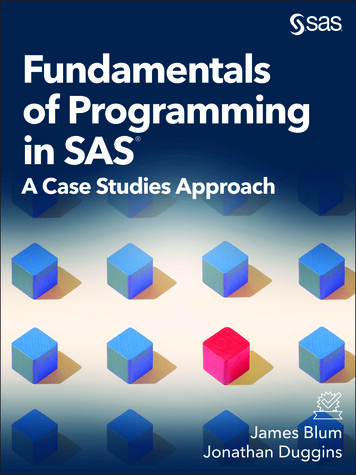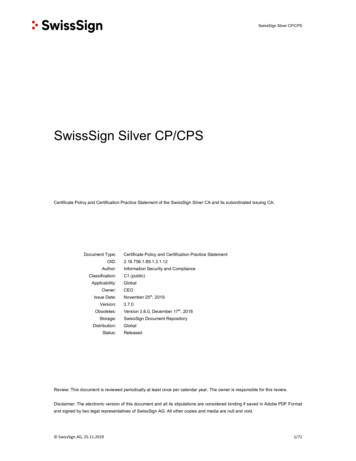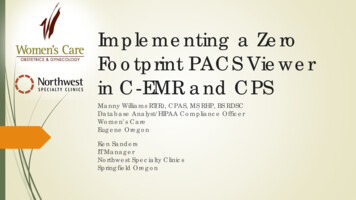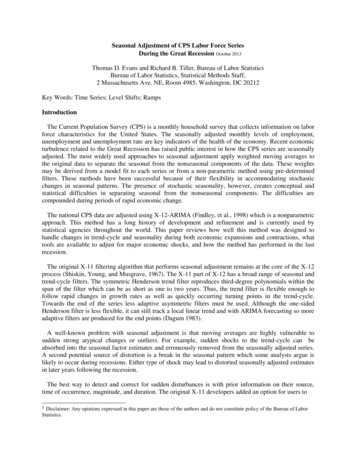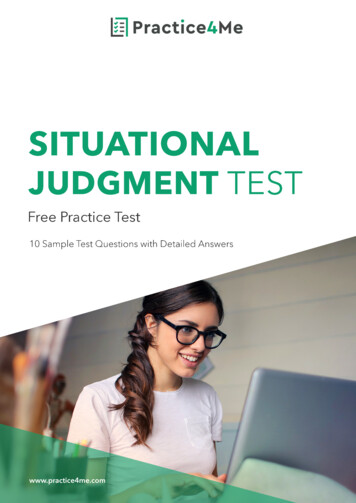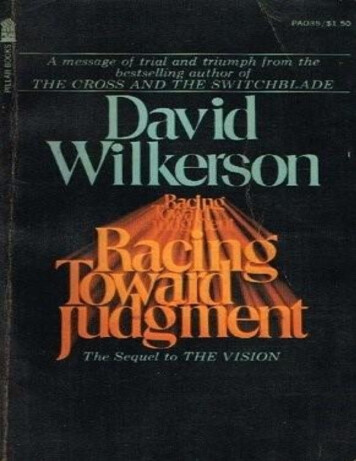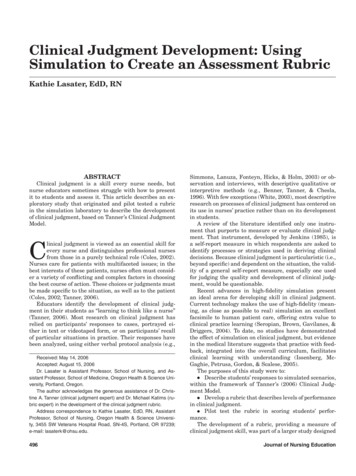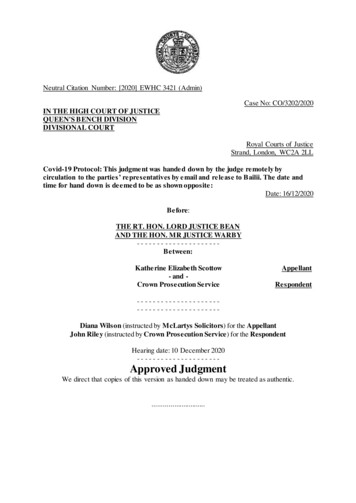
Transcription
Neutral Citation Number: [2020] EWHC 3421 (Admin)Case No: CO/3202/2020IN THE HIGH COURT OF JUSTICEQUEEN'S BENCH DIVISIONDIVISIONAL COURTRoyal Courts of JusticeStrand, London, WC2A 2LLCovid-19 Protocol: This judgment was handed down by the judge remotely bycirculation to the parties’ representatives by email and release to Bailii. The date andtime for hand down is deemed to be as shown opposite:Date: 16/12/2020Before:THE RT. HON. LORD JUSTICE BEANAND THE HON. MR JUSTICE WARBY-- --- -- --- --- -- --- --Between:Katherine Elizabeth Scottow- and Crown Prosecution ServiceAppellantRespondent-- --- -- --- --- -- --- ---- --- -- --- --- -- --- --Diana Wilson (instructed by McLartys Solicitors) for the AppellantJohn Riley (instructed by Crown Prosecution Service) for the RespondentHearing date: 10 December 2020-- --- -- --- --- -- --- ---Approved JudgmentWe direct that copies of this version as handed down may be treated as authentic.
Scottow v CPS [2020] EWHC 3421 (Admin)Approved JudgmentMr Justice Warby:Introduction1.This is an appeal against conviction by Kate Scottow, aged 39. On 7 February 2020,after a trial in the Magistrates’ Court at St Albans, she was convicted by District JudgeMargaret Dodd of one offence of improper use of a public communications network,contrary to section 127(2)(c) of the Communications Act 2003. This provides that aperson commits an offence if “for the purpose of causing annoyance, inconvenience orneedless anxiety to another [she] persistently makes use of a public electronicnetwork”. Ms Scottow now appeals by way of case stated.2.The case stated raises five questions, that fall into two main categories. First, there arequestions of procedural error. It is Ms Scottow’s case that the prosecution was an abuseof process, the charge was duplicitous, and partly out of time. Secondly, there arematters of substantive law. Ms Scottow says that those acts that were within time couldnot be described as “persistent” and, in any event, on a proper interpretation andapplication of s 127(2)(c), the facts alleged disclosed no case to answer, so and it waswrong in law to convict her on that factual basis. In this regard she relies, among otherthings, on human rights arguments founded on the right to freedom of expression.3.At the conclusion of the hearing we announced that the appeal would be allowed andthe conviction quashed. It follows that all orders made on conviction will also bequashed. These are my reasons. As I explain below, I would answer questions 3, 4 and5 in Ms Scottow’s favour. The conviction was vitiated by errors of law and for thatreason cannot stand.The factual background4.The prosecution stemmed from complaints by Stephanie Hayden about messagesposted on social media. Ms Hayden is a trans woman, with a public profile as an activistand advocate on transgender rights. It is common ground that she is to an extent apublic figure. Ms Scottow describes herself as a radical feminist, and takes views thatoppose some of those advocated by Ms Hayden.5.The facts of the matter have not been as easy to identify as they should have been. Thisis a result of several factors: the fact that the prosecution did not obtain all the contextualmaterial for the offending messages; the somewhat disorderly way in which the casefor the prosecution was presented at trial; the diffuse nature of the arguments for theappellant; the limited fact-finding in the judgment of the District Judge; and theunorthodox nature of the case stated. The formal information that was laid before theMagistrates Court is not before us, nor is the summons, nor were the essential factsrelied on set out in the prosecution opening, nor has anyone prepared a basic chronologyof the key facts. An argumentative chronology was prepared by Counsel for the purposeof the case stated and Skeleton Argument, but this was not adopted nor commentedupon by the District Judge. It unhelpfully weaves together facts which were, and thosewhich are not clearly found by the District Judge, together with comment andsubmission, and contains some errors and omissions. To a substantial extent, it has beennecessaryto reconstruct events, using the papers before us. I am confident however thatthe following facts were established before the District Judge, or are agreed, or clearbeyond dispute.
Scottow v CPS [2020] EWHC 3421 (Admin)Approved Judgment6.The acts of using a public telecommunications network that were relied on by theprosecution at trial consisted of 17 messages on social media: 16 tweets which MsScottow admitted making, and 1 message on Mumsnet from a usernameBurntMarshmallow, which she could not recall. The nature of Twitter and Mumsnetare by now well known. The former is a social media platform for microblogging, thecharacteristics and workings of which are set out in Chambers v Director of PublicProsecutions [2012] EWHC 2157 (Admin) [2013] 1 WLR 1833 [7-10] (Lord Judge CJ)and in the Appendix to Monroe v Hopkins [2017] EWHC 433 (QB) [2017] 4 WLR 68entitled “How Twitter Works”. Mumsnet is a well-known website providing an onlinecommunity forum for parents.7.Seven of the messages relied on by the prosecution were posted in 2018 (“the 2018Messages”). The sequence of key events during 2018 is as follows.(1) On 9 September 2018, Ms Hayden, using her Twitter handle @flyinglawyer73,posted a tweet which started: ‘You know not so long ago people like you had nocivil rights! Yet you ’ Ms Scottow using her Twitter handle of @bustedwench,tweeted in response as follows (“Tweet 1”):“Let’s hope they take a serious stance on your racism”Evidently, she took Ms Hayden’s tweet to be addressed to a black person.(2) On 12 September 2018, Ms Hayden issued a Part 8 claim in the County Court atLeeds under claim no E73LS068, alleging harassment by four defendants, ofwhom Ms Scottow was one. Ms Hayden made a witness statement, but did notformally serve the claim form or the witness statement on Ms Scottow.(3) On 24 September 2018, Ms Hayden and Ms Scottow entered into a writtensettlement agreement by which Ms Hayden agreed not to pursue any legal remedyagainst Ms Scottow in the Leeds proceedings, or to bring any further legalproceedings against her, provided that she complied with certain undertakings,recorded in paragraph 3 of the document. These were to:“(a) Delete any tweet on the Twitter account known as“@BustedWench” referring to “@flyinglawyer73”,or“Stephanie Hayden” by 4pm on Tuesday 2 October 2018. Anotice of discontinuance was filed with the County Court andserved on 28 September 2018.(b) Not tweet, retweet, or quote tweet on the Twitter flyinglawyer73”, or “Stephanie Hayden”.(c) Not make any publication on any form of social media statingthat the Claimant is a racist or has published anything racist onany form of social media.”(4) A notice of discontinuance was filed with the County Court and served on 28September 2018. Ms Hayden posted the settlement agreement online in some form.
Scottow v CPS [2020] EWHC 3421 (Admin)Approved Judgment(5) On 1 or 2 October 2018, Ms Scottow tweeted a copy of the notice ofdiscontinuance, tagging in Ms Hayden (“Tweet 2”). To do this, Ms Scottow useda newly created Twitter account with the handle @AliceHampton. By this time,Ms Scottow had blocked Ms Hayden from her @bustedwench account.(6) On 2 November 2018, Ms Scottow tweeted on the @bustedwench account asfollows (“Tweet 3”), by way of a reply to tweets by others:“‘Sadly, I’m not allowed to discuss as per his bullying contract,good will out though, and he will be fucked in a few year’s time”(7) On 6 November 2018, Ms Scottow took, and posted on her @bustedwenchaccount, a screenshot of a post by Ms Hayden, with the message (“Tweet 4”):“This person is not a racist, xenophobic larpinglawyer/transwoman. This person is a crook using the transfaçade to ensure they aren’t caught. A pig in a wig”(8) On 9 November 2018, Ms Scottow used her @bustedwench account to tweet apost by Ms Hayden critical of Mumsnet with the statement (“Tweet 5”):“he is a very sick individual I’ve evidence of that”(9) On 9 November 2018, Ms Scottow posted a further tweet on her @HampsonAliceaccount, in which she tagged Ms Hayden. Ms Hayden had tweeted about anintersex advocate, critical of “anonymous freak trolls obsessing and speculatingover” her “every move” and suggesting that “Something must have upset them”.Ms Scottow’s tweet (“Tweet 6”) said“Christ, surprised your memory has held up given you’reclaiming PiP for it”.(10) On a date unknown on or before 11 November 2018, a message was left onMumsnet from an account named BurntMarshmallow as follows (“Message 7”):“‘I have many leads on the claimant they’re on pip for memoryloss’(11) On 11 November 2018, Ms Hayden made a report to West Yorkshire Police,alleging harassment and malicious communication by Ms Scottow. She made astatement.(12) On 1 December 2018, at the instigation of the West Yorkshire Police, PC Kitchenof the Hertfordshire Police arrested Ms Scottow on suspicion of harassment andmalicious communication. Ms Scottow was interviewed. She admitted the twoTwitter accounts were hers, and that she had posted the 6 tweets. She did not acceptposting Message 7. She denied committing any offence. At the time of arrest, theofficer seized Ms Scottow’s Samsung mobile phone and her ASUS laptop. Thepolice, apparently expecting a guilty plea, decided, later on, that downloading datafrom the phone or computer would be disproportionate and unnecessary.
Scottow v CPS [2020] EWHC 3421 (Admin)Approved Judgment(13) On 1 December 2018, Ms Hayden posted 5 tweets highlighting the fact of the arrest(though not Ms Scottow’s name) describing this as “positive news regarding the#harassment I have received in recent weeks”, and as “sending a clear signal that#transphobia and #harassment will not be tolerated”.(14) In early December 2018, Ms Hayden issued proceedings against Ms Scottow inthe High Court under action number QB-2018-000294. On 18 December 2018, MsHayden appeared before Jason Coppel QC, sitting as a Deputy Judge of theQueen’s Bench Division, and obtained an interim injunction, prohibiting MsScottow until trial or further order from publishing “any personal informationrelating to” Ms Hayden “on any social media platform” as well as (morespecifically) “mis-gendering” her on any social media platform, publishinganything linking her current female identity to her former male identity, andanything stating or implying that she “is a racist or has published anything raciston any form of social media”. Ms Scottow was neither present nor represented atthe hearing when this order was made.(15) Later the same day, Ms Hayden posted 4 tweets contained news of the injunction,giving a summary, and tweeted a photo of the order (but with Ms Scottow’s nameredacted), asking others to retweet.8.The public record shows that the civil proceedings against Ms Scottow remain alive, butstayed pending the outcome of these proceedings.9.The next relevant event occurred on 1 March 2019, when Ms Scottow posted the 10further tweets relied on by the prosecution (“the 2019 Messages”). By this time she hadclosed, or at least ceased to use, the @bustedwench account. She used a further,different Twitter account, with the name MandiMcGirlDick and the handle@BishBas58122507. Copies of this series of tweets are in our papers, in the form ofscreenshots. Not all the context is before us, but the content and the context of whichwe are aware can be summarised as follows:(1) At some point before 17:55 on 1 March 2019, Ms Hayden tweeted, in response toan unknown tweet, that“the fact is the Police and CPS need to choose their battlescarefully. Whilst there is lots that we do not like the fact is mostof it does not even begin to cross the line into criminal liabilit y.”(2) This drew a response from @Kateco, that “You’d know”, to which Ms Haydenreplied:“Indeed I do. That why my application for a civil interiminjunction was successful.”(3) At 17.55, Ms Scottow replied as follows (“Tweet 8”)“Was that not because the subject of the injunction was unableto attend? Why do you people keep trying to punish others whodisagree with you?”
Scottow v CPS [2020] EWHC 3421 (Admin)Approved Judgment(4) The conversation continued, involving three other parties. At 18:18. Ms Scottowtweeted as follows (“Tweet 9”)“And hopefully the CPS will view these complaints in future asharassment and vicious. A complete waste of the public’sresources. Surely better to focus on more pressing issues.”(5) Ms Hayden tweeted – whether in reply to Tweet 9 or otherwise, is not wholly clear:“Every case is considered individually on its merits. Just becauseone case fails it does not mean that any other case fails (orsucceeds). And just because you have a political viewpoint doesnot mean alleged harassment is automatically vexatious.”(6) At 18:52, Ms Scottow tweeted again as follows (“Tweet 10”)“You must be nervous though given your extensive amount ofcases for harassment and what not”(7) Evidently, Ms Hayden was unaware that MandiMcGirlDick was an account usedby Ms Scottow. She replied to Tweet 10, saying “I am absolutely fine thank you”.She then replied to an unknown tweet (the record does not reveal its content):“Absolutely. Unlike you I actually do know the law (despitewhat you may read elsewhere). I think obtaining the firstinjunction in English legal history restraining misgendering anddead naming speaks for itself really. However. I am sure youknow better than a High Court Judge”(8) At 18:59 Ms Hayden tweeted as follows (“Tweet 11”)“Surely the whole point of an injunction is that it’s kept quiet.How would you know it was the first? Have you insiderknowledge? Also, why has it not been reported as such?Something is amiss.”(9) Ms Hayden replied to Tweet 10, saying“Depends what the injunction is for. This one was in harassmentso no need to keep it quiet. As for ‘reported as such’, watch thisspace as they say. I also have access to legal databases, whichyou almost certainly do not.”(10) At 19:04, Ms Scottow replied as follows (“Tweet 12”):“You just said it was for misgendering and deadnaming, and nowit’s for harassment? It was posted online, doesn’t seem thatground-breaking.”(11) Ms Hayden replied to Tweet 12:
Scottow v CPS [2020] EWHC 3421 (Admin)Approved Judgment“Is that your considered ‘expert’ legal opinion? The cause ofaction it was granted in was harassment, the elements of theinjunction include restraining misgendering and dead naming.”(12) At 19:11, Ms Scottow replied as follows (“Tweet 13”)“So how can you confirm it’s the first of its kind wheninjunctions are usually kept in legal settings as opposed to beingposted online?”(13) Someone by the name Theresa Davis tweeted:“Not necessarily in legal terms an injunction is pretty much a runof the mill procedure there are hundreds every day not reallyworth reporting about.”(14) At 19:51, Ms Scottow replied to this tweet in the following terms (“Tweet 14”):“Well exactly my point. Stephanie has publicly stated that theinjunction they sought was a first of its kind, I mean that suggestsit’s worthy of world-wide coverage so why has this not happeneddespite Stephanie’s assurance that media interest has beencourted?”(15) Ms Hayden replied to Tweet 14, saying:“This one was reported and there may well be another reportabout it in the very near future focusing on the fact it was almostcertainly the first of its kind in England and Wales. Let’s justsee. Trolls are going to troll Theresa lol!”(Meaning “laugh out loud”).(16) At 19:54, Ms Scottow tweeted a reply (“Tweet 15”) asking:“Where was it reported? Have you a link? Seems bizarre that ithasn’t had more coverage given your insistence that it’s the firstof its kind.”(17) Someone by the name Jennie Bujold tweeted“You’re inestimably more sensible than I [emoji] What a creephuh?”(18) At 20:16, Ms Scottow tweeted the following reply, tagging Jenni Bujold and MsHayden (“Tweet 16”):“Oh are you referring to Stephanie Hayden who couldn’tproduce evidence of their injunction being the ‘first of its kind’despite their insistence that it was”
Scottow v CPS [2020] EWHC 3421 (Admin)Approved Judgment(19) At a time unknown on 1 March 2019, Ms Scottow posted a reply to an unknowntweet from @MRKHvoice as follows (“Tweet 17”):“‘What is Hattie’s take on the court case?”10.Ms Scottow attended a police station for re-interview, to address the 2019 Messages.She gave a no comment interview, on advice. On 27 August 2019, an information waslaid, and a summons was issued alleging that, for the purpose of causing annoyance ,inconvenience or needless anxiety, Ms Scottow had “made a false statement” on apublic electronic communication network. That is an offence contrary to s 127(2)(a) ofthe Communications Act 2003. The charge was later amended to allege the offenceunder s 127(2)(c), which came before the District Judge for trial in February 2020.The trial11.The trial was listed for 6 and 7 February 2020. On the first day, the defence applied forthe proceedings to be stayed or dismissed on a number of bases, submitting as follows:(1) the proceedings should be stayed as an abuse of process on the grounds that it wasimpossible for Ms Scottow to have a fair trial; (2) it was artificial and duplicitous totreat the various messages relied on as a single course of conduct: the 2018 Messagesand the 2019 Messages should be looked at, and should have been charged – if at all separately; (3) on that basis, any prosecution in respect of the 2018 Messages would bebarred by the 6-month time limit in s 127 of the Magistrates Courts Act 19801; (4) theprosecution in respect of the 2019 Messages, though in time, was bound to fail, as thesewere incapable in law of founding a charge under s 127(2)(c); (5) alternatively, and inany event, Ms Scottow’s messages could not properly be regarded as “persistent”conduct, or as having the purposes alleged, upon the true construction of the section, asinterpreted and applied in the light of the right to freedom of expression, guaranteed byArticle 10 of the Convention, and s 3 of the Human Rights Act 1998 (“HRA”). TheDistrict Judge dismissed all these applications and proceeded to hear argument andevidence from the prosecution and defence on the substantive charge.12.The fact of the messages was not in dispute, nor was Ms Scottow’s authorship of the16 tweets. It was accepted that the messages had been sent over a “publictelecommunications network”; that point was decided by this Court in Chambers v DPP(above). The issues were whether the messages represented the “persistent” use of sucha network by Ms Scottow “for the purpose of causing annoyance, inconvenience orneedless anxiety” to Ms Hayden within the meaning of s 127(2)(c).13.The prosecution submitted in opening that the case was about“the use of social media, Twitter, to send or cause to be sentmessages of offence fromone person to another or so that anotherperson would see them” (emphasis in original).It was said to be “a reasonably straightforward case” in which the messages relied on“had at their heart the purpose of causing annoyance, inconvenience or needlessanxiety” to Ms Hayden. It was submitted that:“ a magistrates’ court shall not try an information unless theinformation was laid within six monthsfrom the time when the offencewas committed.”1
Scottow v CPS [2020] EWHC 3421 (Admin)Approved Judgment“These states, the purpose of the communication(s), are of arelatively lower effect when compared to other states of distressin other offences eg " . Harassment Alarm or Distress .” Whether the messages actually had that effect or may havedone is irrelevant and the Crown do not have to prove that themessages had the desired effect [but] If the Crown are in aposition to prove that the messages did have that effect then that goes a long way to underpin the purpose.”(emphasis in original).14.Three prosecution witnesses were called. Two were police officers, who gave formalevidence, establishing the facts and content of the interview and other formal matters.The third was Ms Hayden. In her evidence in chief, she gave evidence of “online abusefrom trolls” from 9 September 2018, of which Bustedwench account “stood out”. Shedescribed a Twitter “pile on” as a result. She described the steps she took to investigate,the compromise agreement, and the injunction application. She gave evidence aboutwhat she considered to be the motives or intentions of Ms Scottow, her own views aboutthe meaning of the 2018 messages, their impact on her feelings, and whether they were(as she said they were) abusive and harassing.15.Her evidence as to the 2019 Messages was, according to the Court clerk’s note:(in chief) “I received tweet around March 2019, direct tweets,from account, Bishbash. Never heard of it. Tweets 1/3/19 andbottom one tagged me and says ‘ why do you people ’referingto the injunction. I did not know who it was, so I entertained aconversation for a few tweets. Later that day contacted bysomeone, so I researched the account and material in the mediasection which convinced me it was her, her dog featured againas with Bustedwench account. So back to the police(Cross-examined) 1/3 was next contact. Talking about MirandaYardley, and MandiMcGirldick response. I was referring toinjunction against defendant. She responded, not offensive but inbreach of injection. It is persistent, not offensive. She offers aview, I make it clear, I engaged. Not offensive, I just disagreed.It’s not just free speech, I thought it was when I realised it washer, I did not take offence, but breach of injunction. Took theview it was stupid. 1/3 not offensive, but breach of injunction. Real objection is notthat people disagree with me accept right to views.”16.The note records the following more general evidence from Ms Hayden, under crossexamination:“Many people believe cannot change sex, support right to thatview. Discuss female only spaces, and sport, I do not object tothat. I do not disagree with people taking issues. I do not call
Scottow v CPS [2020] EWHC 3421 (Admin)Approved Judgmentthem bigots when they post on self identification. What is notacceptable is to contact individuals, publish photos, ‘deadnaming’, using incorrect pronouns etc.”17.Ms Scottow gave evidence, and according to the case stated “she denied being persistentor ‘out to annoy’”. It appears that the Judge made no other note of her evidence.Evidence was read from a doctor, Dr Collins, whose evidence went to Ms Scottow’shealth.The Judge’s reasons18.The District Judge gave full reasons. I shall return to some of the detail when I addressthe questions raised by the case stated, but her main conclusions can be summarised asfollows (I have added paragraph numbers for ease of reference).19.The Judge accepted the evidence of Ms Hayden, and rejected that of Ms Scottow. Shefound Ms Hayden was “both distressed and angry about what she had read”: [7]. Shesaid Ms Scottow “felt able to make personal and offensive comments to and about her”although they had never interacted before. This was not “part of a debate, it was abusefor the sake of it” which “contributed nothing to any debate”: [8]. The Judge said thatshe had Article 10 rights in mind, but that these are not unfettered. Ms Scottow’scomments were “merely personal comments aimed at Ms Hayden”, which contravenedthe “rule” that adults teach children, and should follow themselves: “to be kind to eachother and not call each other names”: [13]. Ms Scottow’s comments about PIP weremade “out of anger” with “no thinking behind” them, and “a clear example of acomment which Ms Hayden found distressing, and forms no part of any debate”: Inaddition (ibid.)“mis gendering, referring to Ms Hayden as ‘he’ and referencesto ‘you people’ and ‘pig in a wig’ clearly take any commentaway from general debate, personalising the comment andrendering it simply unkind and abusive your repeated use ofmale pronouns was deliberate ”20.The Judge addressed the issues of persistence and purpose as follows:(1) The Judge was “entirely satisfied” that the requirement of persistence was met:[18]. Persistence is “not solely a question of quantity or frequency” but also aquestion of a determination to continue communications after realising (due to thecourt proceedings) that “your comments were not welcomed”. The fact that MsScottow was “prepared to breach” the settlement and the injunction “demonstratespersistence”: [15].(2) The Judge was also “entirely satisfied” that Ms Scottow’s “purpose and intent wereone and the same: to cause annoyance and needless anxiety to Ms Hayden”: [18].Whether Ms Scottow tagged or blocked Ms Hayden “does not have muchbearing”, because the sender of a communication on the internet has little controlover who will see it. Ms Scottow could not “in the circumstances of this case” sayshe did not realise Ms Hayden “would see what you had written”: [14]. She wassatisfied that Ms Scottow “knew that she would see and that that was yourintention”: [17].
Scottow v CPS [2020] EWHC 3421 (Admin)Approved JudgmentQuestions for this Court21.The questions referred for the opinion of this Court are as follows:(1) Should this case have been stayed as an abuse of process on any of the arguedgrounds in the updated skeleton argument served 5 February 2020?(2) Should the case have been stayed as an abuse in accordance with [DPP v Ara[2002] 1 WLR 815]?(3) Was the charge duplicitous and therefore should the court have required theprosecution to split the charge and then ruled that anything pre 27.2.19 was out oftime (in reality on the evidence pre-9.11.18) or stayed any prosecution of a chargewith an end date pre 27.2.19 as an abuse of the court’s process.(4) (a)Did the judge correctly interpret and apply the law in light of theinterpretation that would need to be given in light of Article 10 ECHR and s3Human Rights Act 1998?(b)Should the case have been stopped on a submission of no case?(5) Was it proper in law to convict on the facts as alleged (7 tweets only 3 of themdirectly notified to the complainant September to November 2018 and 9 tweets on1 March 2019 none of which were said to be objectionable until the complainantlearnt (by investigation) that they came from an account operated by thedefendant)? i.e. was there evidence on which the Court could come to its decision?Discussion22.In my judgment, the prosecution and the Judge had insufficient regard to the legalcontext, which is all-important.23.In 1988, Parliament enactedthe Malicious Communications Act. By s 1(1), as amendedin 2001, a person is guilty of an offence if he“ sends to another person(a) A letter, electronic communication or article of anydescription which conveys (i) a message which is indecent orgrossly offensive; (ii) a threat; or (iii) information which is falseand known or believed to be false by the sender, . if his purpose, or one of his purposes, in sending it is that itshould, so far as falling within paragraph (a) above, causedistress or anxiety to the recipient ”The offence is punishable by up to 2 years’ imprisonment, and a fine, if prosecuted onindictment.24.In 1997, Parliament enacted the Protection from Harassment Act 1997 (“PfHA”),creating the criminal offence and statutory tort of harassment. The PfHA is now
Scottow v CPS [2020] EWHC 3421 (Admin)Approved Judgmentfamiliar. It prohibits a person from pursuing a course of conduct which amounts toharassment of another, and which the person knows or ought to know amounts toharassment, of the other. Section 2 creates the crime and section 3 the tort. They are coextensive in content. There is a great deal of jurisprudence on the question ofharassment, and in particular the tort of harassment by publication. A helpful summarycan be found in the very recent judgment of Nicklin J in Hayden v Dickenson [2020]EWHC 3291 (QB) [40-44]. Points of particular relevance identified at [44] are asfollows (for simplicity, I omit most of the internal citations):“(ii) The behaviour said to amount to harassment must reach alevel of seriousness passing beyond irritations, annoyances, evena measure of upset, that arise occasionally in everybody’s dayto-day dealings with other people. The conduct must cross theboundary between that which is unattractive, even unreasonable,and conduct which is oppressive and unacceptable. To cross theborder from the regrettable to the objectionable, the gravity ofthe misconduct must be of an order which would sustain crimina lliability under s.2 (iii) It does not follow that any course of conduct whichcauses alarm or distress therefore amounts to harassment; thatwould be illogical and produce perverse results .(iv) s.1(2) provides that the person whose course of conduct isin question ought to know that it involves harassment of anotherif a reasonable person in possession of the same informationwould think the course of conduct involved harassment. The testis wholly objective. “The Court’s assessment of the harmfultendency of the statements complained of must always beobjective, and not swayed by the subjective feelings of theclaimant”. (vi) Where the complaint is of harassment by publication, theclaim will usually engage Article 10 of the Convention and, as aresult, the Court’s duties under ss.2, 3, 6 and 12 of the HumanRights Act 1998. The PfHA must be interpreted and appliedcompatibly with the right to freedom of expression. It would bea serious interference with this right if those wishing to expresstheir own views could be silenced by, or threatened with,proceedings for harassment based on subjective claims byindividuals that they felt offended or insulted (vii) In most cases of alleged harassment by speech there is afundamental tension. s.7(2) PfHA provides that harassmentincludes “alarming the person or causing the person distress”.However, Article 10 expressly protects speech that offen
giving a summary, and tweeted a photo of the order (but with Ms Scottow’s name redacted), asking others to retweet. 8. The public recordshows that the civil proceedings against Ms Scottow remain alive, but stayed pending the outcome of these proceedings. 9. The next relevant even
